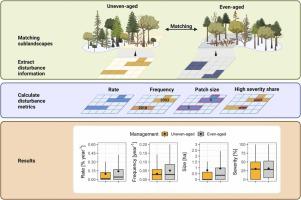当前位置:
X-MOL 学术
›
Forest Ecol. Manag.
›
论文详情
Our official English website, www.x-mol.net, welcomes your feedback! (Note: you will need to create a separate account there.)
Are uneven-aged forests in Central Europe less affected by natural disturbances than even-aged forests?
Forest Ecology and Management ( IF 3.7 ) Pub Date : 2024-03-11 , DOI: 10.1016/j.foreco.2024.121816 Johannes Mohr , Dominik Thom , Hubert Hasenauer , Rupert Seidl
Forest Ecology and Management ( IF 3.7 ) Pub Date : 2024-03-11 , DOI: 10.1016/j.foreco.2024.121816 Johannes Mohr , Dominik Thom , Hubert Hasenauer , Rupert Seidl

|
Natural disturbances from wind and bark beetles have increased strongly in recent decades across Central Europe. As climate change will likely amplify disturbance activity further, disturbances are increasingly threatening the sustainable supply of ecosystem services to society. Management strategies to mitigate disturbances are thus urgently needed. In Central Europe, managing for complex, uneven-aged forests has been suggested as a measure to reduce disturbance risk. However, the scientific evidence for a dampening effect of uneven-aged management on disturbances remains weak and inconclusive. Here, our objective was to assess differences in the disturbance regimes of uneven-aged and even-aged conifer forests during the years 1986 to 2020. We used remote sensing to quantify wind and bark beetle disturbances across four study sites in Austria. The sites span a large environmental gradient and have been under uneven-aged management for many decades. Here, we contrast them with surrounding even-aged forests with similar environmental conditions (uneven-aged forests: 13,440 ha, even-aged forests: 27,910 ha). Specifically, we used a paired-landscape approach, matching uneven-aged with even-aged forests at the level of sublandscapes and controlling for differences in elevation, slope, exposition, topography and the proportion of coniferous species. For each pair of sublandscapes (n= 5000) we quantified differences in disturbance rate, frequency, size and severity between uneven-aged and even-aged forests. Our findings revealed that in uneven-aged forests, disturbance rates were on average 31.3% lower, disturbances returned with a 36.3% lower frequency, and maximum patch sizes were 15.7% smaller than in surrounding even-aged forests. The proportion of high severity disturbance patches was only marginally influenced, being 3.8% lower in uneven-aged versus even-aged forests. Topography strongly modulated the effect of management on disturbance regimes. While disturbance rate was lower in uneven-aged forests overall, it exceeded the rate of surrounding even-aged forests on steep slopes >20° and elevations >1500 m asl. In conclusion, our results suggest that uneven-aged management may partly counteract increases in natural disturbances in Central European forests. However, we also caution that uneven-aged management is not a silver bullet solution for managing forest change, and highlight that adapted forest management approaches should be tailored to local needs and conditions.
中文翻译:

中欧的不均龄森林是否比均龄森林受自然干扰的影响更小?
近几十年来,中欧各地风甲虫和树皮甲虫的自然干扰急剧增加。由于气候变化可能会进一步加剧干扰活动,干扰日益威胁着社会生态系统服务的可持续供应。因此迫切需要减轻干扰的管理策略。在中欧,有人建议对复杂、年龄不均的森林进行管理,作为减少干扰风险的一项措施。然而,关于年龄不均管理对干扰的抑制作用的科学证据仍然薄弱且不确定。在这里,我们的目标是评估 1986 年至 2020 年期间不均匀树龄和均匀树龄针叶林干扰状况的差异。我们使用遥感技术来量化奥地利四个研究地点的风和树皮甲虫干扰。这些地点跨越了很大的环境梯度,并且几十年来一直处于不均匀的管理状态。在这里,我们将它们与周围环境条件相似的同龄森林进行对比(不等龄森林:13,440 公顷,同龄森林:27,910 公顷)。具体来说,我们采用了配对景观方法,在次景观层面将不均龄森林与同龄森林进行匹配,并控制海拔、坡度、暴露、地形和针叶树种比例的差异。对于每对子景观(n = 5000),我们量化了不均匀年龄和均匀年龄森林之间的干扰率、频率、大小和严重程度的差异。我们的研究结果显示,在年龄不均匀的森林中,干扰率平均降低 31.3%,干扰返回频率降低 36.3%,最大斑块大小比周围年龄均匀的森林小 15.7%。高严重干扰斑块的比例仅受到轻微影响,与均匀年龄的森林相比,不均匀年龄的森林低 3.8%。地形强烈调节管理对扰动状况的影响。虽然总体而言,不均龄森林的干扰率较低,但在陡坡 >20° 和海拔 >1500 m asl 上,其干扰率超过了周围均龄森林的干扰率。总之,我们的结果表明,年龄不均匀的管理可能会部分抵消中欧森林自然干扰的增加。然而,我们也警告说,年龄不均匀管理并不是管理森林变化的灵丹妙药,并强调适应的森林管理方法应根据当地的需求和条件进行调整。
更新日期:2024-03-11
中文翻译:

中欧的不均龄森林是否比均龄森林受自然干扰的影响更小?
近几十年来,中欧各地风甲虫和树皮甲虫的自然干扰急剧增加。由于气候变化可能会进一步加剧干扰活动,干扰日益威胁着社会生态系统服务的可持续供应。因此迫切需要减轻干扰的管理策略。在中欧,有人建议对复杂、年龄不均的森林进行管理,作为减少干扰风险的一项措施。然而,关于年龄不均管理对干扰的抑制作用的科学证据仍然薄弱且不确定。在这里,我们的目标是评估 1986 年至 2020 年期间不均匀树龄和均匀树龄针叶林干扰状况的差异。我们使用遥感技术来量化奥地利四个研究地点的风和树皮甲虫干扰。这些地点跨越了很大的环境梯度,并且几十年来一直处于不均匀的管理状态。在这里,我们将它们与周围环境条件相似的同龄森林进行对比(不等龄森林:13,440 公顷,同龄森林:27,910 公顷)。具体来说,我们采用了配对景观方法,在次景观层面将不均龄森林与同龄森林进行匹配,并控制海拔、坡度、暴露、地形和针叶树种比例的差异。对于每对子景观(n = 5000),我们量化了不均匀年龄和均匀年龄森林之间的干扰率、频率、大小和严重程度的差异。我们的研究结果显示,在年龄不均匀的森林中,干扰率平均降低 31.3%,干扰返回频率降低 36.3%,最大斑块大小比周围年龄均匀的森林小 15.7%。高严重干扰斑块的比例仅受到轻微影响,与均匀年龄的森林相比,不均匀年龄的森林低 3.8%。地形强烈调节管理对扰动状况的影响。虽然总体而言,不均龄森林的干扰率较低,但在陡坡 >20° 和海拔 >1500 m asl 上,其干扰率超过了周围均龄森林的干扰率。总之,我们的结果表明,年龄不均匀的管理可能会部分抵消中欧森林自然干扰的增加。然而,我们也警告说,年龄不均匀管理并不是管理森林变化的灵丹妙药,并强调适应的森林管理方法应根据当地的需求和条件进行调整。



























 京公网安备 11010802027423号
京公网安备 11010802027423号